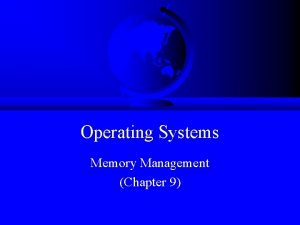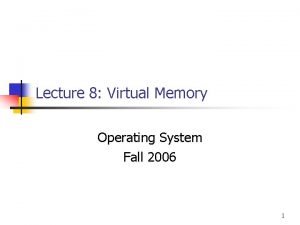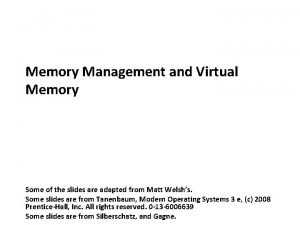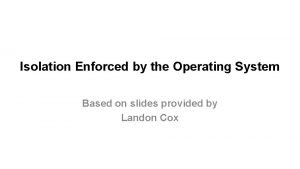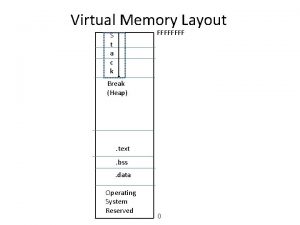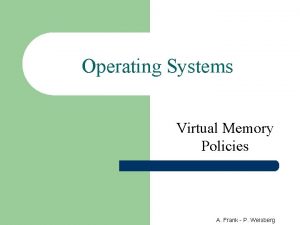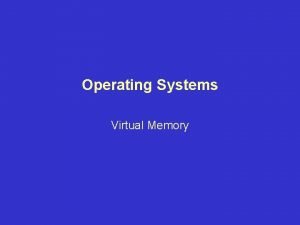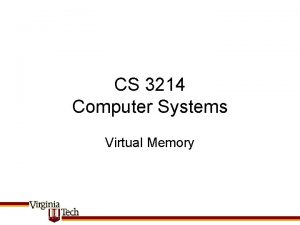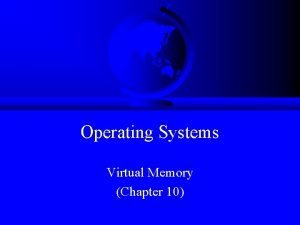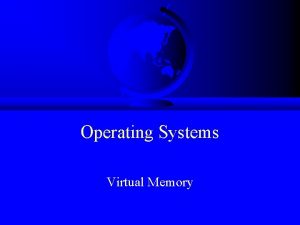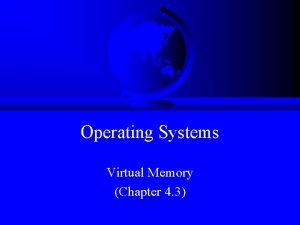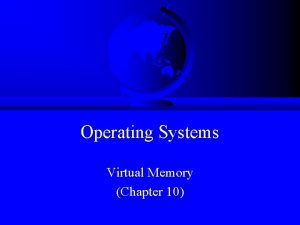Operating Systems Virtual Memory Policies A Frank P




































- Slides: 36

Operating Systems Virtual Memory Policies A. Frank - P. Weisberg

Virtual Memory Management • • • 2 Background Demand Paging Demand Segmentation Paging Considerations Page Replacement Algorithms Virtual Memory Policies A. Frank - P. Weisberg

Memory Management Software • Memory management software depends on whether the hardware supports paging or segmentation or both. • Pure segmentation systems are rare. Segments are usually paged -- memory management issues are then those of paging. • We shall thus concentrate on issues associated with paging. • To achieve good performance we need a low page fault rate. 3 A. Frank - P. Weisberg

Virtual Memory Policies • Need to decide on: – Fetch policy – Placement policy – Replacement policy – Resident Set Management – Load Control 4 A. Frank - P. Weisberg

Fetch Policy • Determines when a page should be brought into main memory. Two common policies: 1. Demand Paging only brings pages into main memory when a reference is made to a location on the page (i. e. , paging on demand only): • many page faults when process first starts but should decrease as more pages are brought in. 2. Prepaging brings in pages whose use is anticipated: • • 5 locality of references suggest that it is more efficient to bring in pages that reside contiguously on the disk. efficiency not definitely established: the extra pages brought in are “often” not referenced. A. Frank - P. Weisberg

Placement Policy • Determines where in real memory a process piece resides. • For paging (and paged segmentation): – the hardware decides where to place the page: the chosen frame location is irrelevant since all memory frames are equivalent (not an issue). • For pure segmentation systems: – first-fit, next fit. . . are possible choices (a real issue). 6 A. Frank - P. Weisberg

Replacement Policy • Deals with the selection of a page in main memory to be replaced when a new page is brought in. • This occurs whenever main memory is full (no free frame available). • Occurs often since the OS tries to bring into main memory as many processes (pages) as it can to increase the multiprogramming level. 7 A. Frank - P. Weisberg

Replacement Policy • Not all pages in main memory can be selected for replacement. • Some frames are locked (cannot be paged out): – much of the kernel is held on locked frames as well as key control structures and I/O buffers. • The OS might decide that the set of pages considered for replacement should be: – limited to those of the process that has suffered the page fault. – the set of all pages in unlocked frames. 8 A. Frank - P. Weisberg

Replacement Policy • The decision for the set of pages to be considered for replacement is related to the resident set management strategy: – how many page frames are to be allocated to each process? We will discuss this later. • No matter what is the set of pages considered for replacement, the replacement policy deals with algorithms that will choose the page within that set. 9 A. Frank - P. Weisberg

Resident Set Management • The OS must decide how many page frames to allocate to a process: – large page fault rate if too few frames are allocated. – low multiprogramming level if too many frames are allocated. 10 A. Frank - P. Weisberg

Resident Set Size • Fixed-allocation policy: – allocates a fixed number of frames that remains constant over time: • the number is determined at load time and depends on the type of the application. • Variable-allocation policy: – the number of frames allocated to a process may vary over time: • may increase if page fault rate is high. • may decrease if page fault rate is very low. 11 – requires more OS overhead to assess behavior of active processes. A. Frank - P. Weisberg

Replacement Scope • Replacement scope is the set of frames to be considered for replacement when a page fault occurs. • Local replacement policy: – each process selects from only its own set of allocated frames. • Global replacement policy: – process selects a replacement frame from the set of all frames; one process can take a frame from another. • We will consider the possible combinations of replacement scope and resident set size policy. 12 A. Frank - P. Weisberg

Local vs. Global Replacement Policies 13 A. Frank - P. Weisberg

Fixed allocation + Local scope • Each process is allocated a fixed number of pages: – determined at load time; depends on application type. • When a page fault occurs, page frames considered for replacement are local to the page-fault process: – the number of frames allocated is thus constant. – previous replacement algorithms can be used. • Problem: difficult to determine ahead of time a good number for the allocated frames: – if too low: page fault rate will be high. – if too large: multiprogramming level will be too low. 14 A. Frank - P. Weisberg

Fixed Allocation: Equal/Proportional • Equal allocation – for example, if there are 100 frames and 5 processes, give each process 20 frames. • Proportional allocation – allocate according to the size of process. 15 A. Frank - P. Weisberg

Fixed Allocation: Priority • Use a proportional allocation scheme using priorities rather than size. • If process Pi generates a page fault: – select for replacement one of its frames. – select for replacement a frame from a process with lower priority number. 16 A. Frank - P. Weisberg

Fixed allocation + Global scope • Impossible to achieve: – if all unlocked frames are candidate for replacement, the number of frames allocated to a process will necessary vary over time. 17 A. Frank - P. Weisberg

Variable allocation + Global scope • Simple to implement -- adopted by many OSs (like Unix SVR 4). • A list of free frames is maintained: – when a process issues a page fault, a free frame (from this list) is allocated to it. – Hence the number of frames allocated to a page fault process increases. – The choice for the process that will loose a frame is arbitrary; It’s far from optimal. • Page buffering can alleviate this problem since a page may be reclaimed if it is referenced again soon. 18 A. Frank - P. Weisberg

Variable allocation + Local scope • May be the best combination (used by Windows NT). • Allocate at load time a certain number of frames to a new process based on application type: – use either pre-paging or demand paging to fill up the allocation. • When a page fault occurs, select the page to replace from the resident set of the process that suffered the page fault. • Reevaluate periodically the allocation provided and increase or decrease it to improve the overall performance. 19 A. Frank - P. Weisberg

The Working Set Strategy • The working set strategy is a variable-allocation method with local scope based on the assumption of locality of references. • The working set for a process at time t, W(D, t), is the set of pages that have been referenced in the last D virtual time units: 20 – virtual time = time elapsed while the process was in execution. – D is a window of time. – W(D, t) is an approximation of the program’s A. Frank - P. Weisberg locality.

The Working Set Strategy • The working set of a process first grows when it starts executing. • Then stabilizes by the principle of locality. • It grows again when the process enters a new locality (transition period): – up to a point where the working set contains pages from two localities. • Then decreases after a sufficient long time spent in the new locality. 21 A. Frank - P. Weisberg

The Working Set Strategy • The working set concept suggests the following strategy to determine the resident set size: – Monitor the working set for each process. – Periodically remove from the resident set of a process those pages that are not in the working set. – When the resident set of a process is smaller than its working set, allocate more frames to it: • If not enough free frames are available, suspend the process (until more frames are available), i. e. , a process may execute only if its working set is in main memory. 22 A. Frank - P. Weisberg

Working-Set Model • = working-set window = a fixed number of page references Example: 10, 000 instructions • WSSi (working set of Process Pi) = total number of pages referenced in the most recent (varies in time): – if too small it will not encompass entire locality. – if too large it will encompass several localities. – if = will encompass entire program. • D = WSSi total demand frames • if D > m Thrashing • Policy if D > m, then suspend one of the processes 23 A. Frank - P. Weisberg

Working-set model 24 A. Frank - P. Weisberg

Keeping Track of the Working Set • Approximate with interval timer + a reference bit. • Example: = 10, 000 – Timer interrupts after every 5000 time units. – Keep in memory 2 bits for each page. – Whenever a timer interrupts, copy and set the values of all reference bits to 0. – If one of the bits in memory = 1 page in working set. • Why is this not completely accurate? • Improvement = 10 bits and interrupt every 1000 time units. 25 A. Frank - P. Weisberg

The Working Set Strategy • Practical problems with this working set strategy: – measurement of the working set for each process is impractical: • necessary to time stamp the referenced page at every memory reference. • necessary to maintain a time-ordered queue of referenced pages for each process. – the optimal value for D is unknown and time varying. • Solution: rather than monitor the working set, monitor the page fault rate! 26 A. Frank - P. Weisberg

Page-Fault Frequency Scheme • Establish “acceptable” page-fault rate: – If actual rate too low, process loses frame. – If actual rate too high, process gains frame. 27 A. Frank - P. Weisberg

Page-Fault Frequency (PFF) Strategy 28 • Define an upper bound U and lower bound L for page fault rates. • Allocate more frames to a process if fault rate is higher than U. • Allocate less frames if fault rate is less than L. • The resident set size should be close to the working set size W. • We suspend the process if the PFF > U and no more free frames are available. A. Frank - P. Weisberg

Working Sets and Page-Fault rates 29 A. Frank - P. Weisberg

Load Control 30 • Determines the number of processes that will be resident in main memory (i. e. , the multiprogramming level): – Too few processes: often all processes will be blocked and the processor will be idle. – Too many processes: the resident size of each process will be too small and flurries of page faults will result: thrashing. A. Frank - P. Weisberg

Load Control • A working set or page fault frequency algorithm implicitly incorporates load control: – only those processes whose resident set is sufficiently large are allowed to execute. • Another approach is to adjust explicitly the multiprogramming level so that the mean time between page faults equals the time to process a page fault: – performance studies indicate that this is the point where processor usage is at maximum. 31 A. Frank - P. Weisberg

Process Suspension • Explicit load control requires that we sometimes swap out (suspend) processes. • Possible victim selection criteria: – Faulting process • this process may not have its working set in main memory so it will be blocked anyway. – Last process activated • this process is least likely to have its working set resident. – Process with smallest resident set • this process requires the least future effort to reload. – Largest process • will yield the most free frames. 32 A. Frank - P. Weisberg

Windows XP (1) • Uses demand paging with clustering. • Clustering brings in pages surrounding the faulting page. • Processes are assigned working set minimum and working set maximum • Working set minimum is the minimum number of pages the process is guaranteed to have in memory. • A process may be assigned as many pages up to its working set maximum. 33 A. Frank - P. Weisberg

Windows XP (2) • When the amount of free memory in the system falls below a threshold, automatic working set trimming is performed to restore the amount of free memory. • Working set trimming removes pages from processes that have pages in excess of their working set minimum. 34 A. Frank - P. Weisberg

Solaris • Maintains a list of free pages to assign faulting processes. • Lotsfree – threshold parameter (amount of free memory) to begin paging. • Desfree – threshold parameter to increasing paging. • Minfree – threshold parameter to being swapping. • Paging is performed by pageout process. • Pageout scans pages using modified clock algorithm. • Scanrate is the rate at which pages are scanned. This ranges from slowscan to fastscan. 35 • Pageout is called more frequently depending upon the amount of free memory available. A. Frank - P. Weisberg

Solaris 2 Page Scanner 36 A. Frank - P. Weisberg
 Virtual memory in os
Virtual memory in os Virtual memory os
Virtual memory os Virtual memory
Virtual memory Virtual memory in memory hierarchy consists of
Virtual memory in memory hierarchy consists of Frank william abagnale
Frank william abagnale Memory management operating system
Memory management operating system Spreading activation psychology
Spreading activation psychology Implicit memory vs explicit memory
Implicit memory vs explicit memory Long term memory vs short term memory
Long term memory vs short term memory Internal memory and external memory
Internal memory and external memory Primary memory and secondary memory
Primary memory and secondary memory Physical memory vs logical memory
Physical memory vs logical memory Which memory is the actual working memory?
Which memory is the actual working memory? Eidetic memory vs iconic memory
Eidetic memory vs iconic memory Shared vs distributed memory
Shared vs distributed memory Weve requiring
Weve requiring Belady's anomaly example
Belady's anomaly example Advantage
Advantage Explain virtual memory in computer architecture
Explain virtual memory in computer architecture Demand paging in virtual memory
Demand paging in virtual memory Virtual memory in os
Virtual memory in os Multilevel page tables
Multilevel page tables Virtual memory os
Virtual memory os Virtual memory
Virtual memory Virtual memory segmentation
Virtual memory segmentation Memory hierarchy
Memory hierarchy Virtual memory os
Virtual memory os Virtual memory os
Virtual memory os Virtual memory is commonly implemented by
Virtual memory is commonly implemented by Virtual memory
Virtual memory Virtual memory os
Virtual memory os Process virtual address space
Process virtual address space Virtual memory
Virtual memory Virtual memory
Virtual memory Stack memory layout
Stack memory layout What are the characteristics of virtual memory
What are the characteristics of virtual memory Virtual memory
Virtual memory





